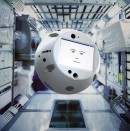What started out as a friendly companion for astronauts in space became much more than that, in just a few years. Cimon, the spherical-shaped, AI-controlled, flying assistant is now ready to take on complex scientific experiments and take part in educational activities for kids.
Cimon, a “floating brain”, was developed in Germany, starting from 2016, by the German Space Agency DLR in collaboration with Airbus and IBM, as an experimental assistant for astronauts. After the successful demonstration of Cimon-1, together with ESA astronaut Alexander Gerst, in 2018, followed by a second demonstration of Cimon-2 in 2020, with Luca Parmitano, the AI assistant is now getting ready for its next mission.
This fall, Cimon-2 is set to accompany ESA astronaut Matthias Maurer on board the International Space Station ISS, where it will do more than provide assistance with documentation or daily routines. For the first time, Cimon will take a more serious role in scientific research, and will also become the subject of research itself, as part of the pilot study “Human interaction with Al and CIMON”.
The spherical assistant is even learning German as its second language, so it can use it for interacting with children, as part of the upcoming educational activities from orbit, which include a tour of the ISS with astronaut Maurer, and an educational experiment related to 3D kinetic gas theory.
In order to be fully prepared for its next mission, Cimon is getting software updates and being adapted to new safety standards. The AI-controlled assistant can see, hear, understand and speak, using multiple high resolution cameras, microphones and a speaker. The IBM Watson AI technology is what enables Cimon to understand speech.
Airbus, on the other hand, provided the autonomous navigation technology. The free-flying robot is able to move and rotate in all directions, and can avoid collisions thanks to its ultrasonic sensors.
This likeable and highly-efficient free-flying astronaut assistant is just the beginning when it comes to bringing AI to space. According to Matthias Biniok, the IBM project lead for CIMON, the ultimate goal is to eventually develop a real astronaut companion that will reach even further, to the moon and on Mars.
This fall, Cimon-2 is set to accompany ESA astronaut Matthias Maurer on board the International Space Station ISS, where it will do more than provide assistance with documentation or daily routines. For the first time, Cimon will take a more serious role in scientific research, and will also become the subject of research itself, as part of the pilot study “Human interaction with Al and CIMON”.
The spherical assistant is even learning German as its second language, so it can use it for interacting with children, as part of the upcoming educational activities from orbit, which include a tour of the ISS with astronaut Maurer, and an educational experiment related to 3D kinetic gas theory.
In order to be fully prepared for its next mission, Cimon is getting software updates and being adapted to new safety standards. The AI-controlled assistant can see, hear, understand and speak, using multiple high resolution cameras, microphones and a speaker. The IBM Watson AI technology is what enables Cimon to understand speech.
Airbus, on the other hand, provided the autonomous navigation technology. The free-flying robot is able to move and rotate in all directions, and can avoid collisions thanks to its ultrasonic sensors.
This likeable and highly-efficient free-flying astronaut assistant is just the beginning when it comes to bringing AI to space. According to Matthias Biniok, the IBM project lead for CIMON, the ultimate goal is to eventually develop a real astronaut companion that will reach even further, to the moon and on Mars.








